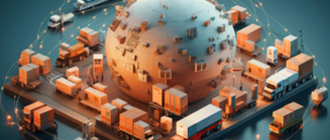
Global Trade In Flux: How APAC SMEs Can Turn Uncertainty Into Opportunity
By FedEx | July 22, 2025
With global trade in flux, APAC SMEs face rising trade regulations, sustainability demands, and customs changes. Learn how to stay compliant, reduce risk, and remain competitive in a shifting landscape.
- The Regional Comprehensive Economic Partnership (RCEP) is set to boost intra-Asia trade by an estimated USD 42 billion annually by 2025.
- Sustainability factors are increasingly critical for market access, with CBAM alone projected to cost Vietnamese exporters up to USD 830 million each year.
- APAC governments are accelerating customs digitalization, with full trade facilitation expected to reduce trade costs by over 11% across the region.
As global trade evolves, businesses across Asia-Pacific (APAC) are facing an increasingly complex and fast-changing environment. Rising tariffs, shifting trade policies, and geopolitical tensions are reshaping traditional supply chains, prompting companies to rethink how and where they operate in this era of constant change.
Compounding the trade outlook are structural pressures – from stricter compliance requirements to digitized customs procedures. In today’s landscape, operational efficiency is no longer enough.
For small- and medium-sized enterprises (SMEs), understanding foreign trade regulations, and how they apply across markets, is essential. This period of disruption also presents a valuable opportunity: businesses that stay informed can reset their supply chains, strengthen compliance practices, and capitalize on emerging trade corridors as global trade patterns evolve.
Key trade shifts in APAC
Businesses across APAC are contending with four critical shifts in the global trade environment. These changes bring both challenges and opportunities – depending on industry exposure, market focus, and supply chain flexibility. Understanding how these forces impact your business is the first step toward long-term competitiveness.
1. Deepening of RCEP trade agreement: New opportunities
The Regional Comprehensive Economic Partnership (RCEP) – the world’s largest – brings together 10 ASEAN member states and five dialog partners: Australia, China, Japan, New Zealand, and South Korea. Collectively, they represent 30% of global GDP.
In force since 2022, the agreement will progressively eliminate tariffs on nearly 92% of traded goods among member countries. Over 50% of ASEAN’s apparel exports already qualify for reduced tariffs under RCEP, which is expected to boost intra-Asia trade by USD 42 billion annually by 2025.
Businesses in sectors like apparel, consumer electronics, and processed foods stand to benefit if they navigate origin protocols and documentation requirements carefully. For example, an Indonesian SME exporting garments to Japan could qualify for zero tariffs by sourcing fabric from Vietnam – provided it follows RCEP rules.
2. Integration of sustainability and trade
Sustainability-linked regulations are quickly becoming the new norm. The European Union’s (EU) Carbon Border Adjustment Mechanism (CBAM), now in its transitional phase, requires EU importers of carbon-intensive goods like iron, steel, aluminum, and cement to report embedded emissions.
The CBAM’s impact across APAC will vary, but countries with high-emission export profiles, such as Indonesia, Malaysia, Thailand, and Vietnam, are expected to feel the most pressure.
Similar frameworks are emerging in other markets, including Korea and Canada. As governments and trade blocs align climate goals with trade policy, monitoring and disclosure of emissions is becoming a prerequisite for market access.
Even preferential trade agreements like RCEP are beginning to incorporate sustainability considerations. Exporters must now factor emissions tracking, disclosure, and operational emissions reduction strategies into their long-term plans.
Vietnam, for example, relies heavily on the EU as a trading partner, with the bloc accounting for about USD 51.7 billion in trade during 2024. Although only about 5% of these shipments fall under CBAM’s scope, compliance costs could reduce Vietnam’s export revenue by about USD 830 million annually.
3. Geopolitical realignment
More than just economics, trade is also about geopolitics. The US-China trading relationship continues to produce tensions that are reshaping global sourcing strategies. The expanded US tariffs on strategic imports such as electric vehicles, semiconductors, and critical minerals have escalated protectionism, sparked reciprocal responses, and added volatility to global trade policy.
Aiming to diversify and derisk supply chains, about 33% of APAC executives – according to the Economist Impact Trade in Transition survey – are creating parallel supply chains, while 29% are maintaining dual supply chains for China and the US.
Markets like Vietnam and Indonesia are becoming attractive alternatives for multinationals seeking cost advantages. For example, an Indonesian SME that previously subcontracted for a China-based firm may now be considered for direct sourcing, as global buyers look for alternative production bases.
4. Customs digitalization
Governments in APAC are mandating fully digital customs ecosystems, with platforms like Singapore’s Networked Trade Platform, Indonesia’s National Single Window, and Australia’s Trade Single Window transforming cross-border clearance. Full digital trade facilitation could cut trade costs by over 11% across the region.
These initiatives aim to reduce clearance times, boost transparency, and align with global standards. However, this move requires businesses to update internal systems, retrain staff, and ensure logistics providers are digitally synchronized. Industries reliant on time-sensitive shipments like pharmaceuticals will benefit from early adoption and close collaboration with logistics providers.
For instance, a Singapore-based pharmaceutical distributor might face delays if a third-party logistics provider fails to update digital authentication protocols, highlighting how even tech-forward firms can be affected by digital challenges.
To help you save time and minimize delays, FedEx Electronic Trade Documents helps you submit customs paperwork electronically, streamlining the clearance process and supporting compliance with evolving trade regulations.
How SMEs can adapt to global trade policy changes
Adapting to evolving global trade policy requires a combination of awareness, strategy, and execution. Businesses across APAC must proactively build resilience into every layer of operations – from compliance to contracts. Here’s how:
1. Stay informed and upskill your team
Trade policy changes often occur without warning – and staying current is essential to avoiding costly delays, penalties, or rejected shipments.
Regular updates on shifting trade regulations, classification rules, and documentation protocols can make the difference between smooth clearance and supply chain disruption. Consider using the FedEx Tariff Info Hub to stay updated on the latest news.
Combine this with structured staff training to ensure your team is fluent in key trade terms, digital documentation, and classification protocols. With FedEx Trade Solutions, our team of trade experts also offers customized compliance training on topics such as customs duties, product classification, and compliance best practices to help you build internal capability.
2. Diversify sourcing and stress-test operations
Supply chain fragility remains a top risk. Avoid over-reliance on single suppliers or countries. A “China+1” or multi-source strategy can help prevent bottlenecks. According to a Gartner supply chain survey, 57% of industrial manufacturers with operations in China are considering the “supplier+1” strategy.
Stress-test your supply chain by modeling disruptions and developing contingency plans for your most critical materials or markets.
3. Embrace trade tech and centralize documentation
Digital trade tools reduce human error and improve cross-border transparency. Adopt e-invoicing, e-certificates of origin when permissible, and near-real-time shipment tracking to enable faster cross-border transactions. Centralized dashboards also help you meet foreign trade regulations quickly and accurately.
At FedEx, we integrate these capabilities into our shipping tools, streamlining documentation and enabling near-real-time updates.
To further support appropriate shipment documentation, particularly for APAC businesses shipping to the US, we’ve also launched two industry-leading solutions on FedEx Ship Manager: Customs AI, an AI-powered chatbot that prompts customers to provide specific item descriptions and assists them in the selection of matching HS codes, and a Harmonized Tariff Schedule (HTS) Code Lookup feature that assists customers in their selection of HTS codes based on their item descriptions.
4. Collaborate with trade experts and partners
Navigating foreign trade regulations such as tariffs, origin rules, and changing documentation can be daunting, especially when dealing with multiple markets. Building trusted relationships with experienced trade partners helps reduce compliance risk.
FedEx Trade Solutions gives businesses access to a wide range of expert-led services designed to address specific trade challenges. Whether you have a classification query or need help resolving a regulatory issue, our consultants work closely with you to create tailored solutions.
Strong partnerships like these do more than reduce paperwork; they help you build business resilience, giving you early warnings when changes in trade policy occur.
5. Conduct regular compliance audits
Review HTS codes, declared values, Incoterms, and country-of-origin documentation regularly. Even minor inconsistencies can result in fines, clearance delays, or both. Internal audits help ensure your processes meet destination country requirements. Make use of our tips and guides on Tariff Info Hub to self-assess and align with trade rules.
6. Build flexibility into contracts
The ability to renegotiate pricing, delivery dates, or routing terms is essential in today’s trade environment. Include clauses for price adjustments, alternative routing, and tariff changes. Contracts should also anticipate customs delays or shipping disruptions. Consider escalation clauses and alternative dispute resolution mechanisms to keep goods moving.
Global trade in 2025 may be more complex, but it also brings new opportunities for those who prepare. As trade regulations continue to change, businesses that proactively monitor policy changes, digitize their operations, invest in strong partnerships, and diversify their supply chains will be better equipped to manage uncertainty.
The ability to respond quickly and compliantly – especially in areas like sustainability, customs and regional agreements – will be a defining factor for growth in the years ahead.
***
Head to our Tariff Info Hub for the latest updates on trade regulations.
SHARE THIS STORY
- 85% Of APAC Businesses Plan To Expand Into Europe, According To New FedEx Report
- Generative AI: A New Frontier
- How To Ship A Giant Panda
- The Rise Of Intra-Asia Trade: Opportunities In The China-Southeast Asia Corridor
- Where Do Old Planes Go When They Retire?
- What’s So Dangerous About Coconuts? Your Guide To Dangerous Goods Logistics
Sign up now and save on your shipping rates!
Sign up now and earn discounts by shipping instantly with FedEx Ship ManagerTM at fedex.com.
Recommended For You

Supply Chain 5.0: How To Diversify Supply Chains In 2024
Kawal Preet shares tips on how to build multi-dimensional supply networks and how diversified supply chains can build resilience.
Read More
Is The RCEP Trade Deal A Springboard For Cross-Border Trade in APAC?
Is the Regional Comprehensive Economic Partnership driving growth in Asia and beyond? Importers and exporters in APAC are exploring ways to benefit.
Read More
How The RCEP Trade Agreement Drives Growth For Vietnam’s SMEs
The Regional Comprehensive Economic Partnership (RCEP) is lowering barriers to global trade for Vietnam’s SMEs. Here’s how your business can benefit.
Read More


